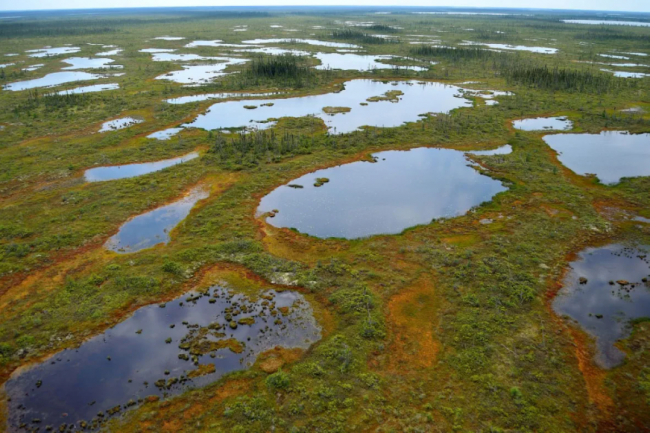Articles Menu

Mar. 18, 2022
Listen to this episode here.
Roughly 500 kilometres north of Thunder Bay, Ont., lies one of the most carbon-rich peatlands on the planet. This water-logged landscape of lakes, ponds and rivers carpeted in moss is known as the Hudson Bay Lowlands — or the "breathing lands" to nearby First Nations.
But along with its status as an enormous stash of carbon, the area has become synonymous with a mining development known as the Ring of Fire, which the Ontario government has supported for more than a decade and included in a new "critical minerals" strategy announced by Ontario Premier Doug Ford today.
With this renewed push by the Ford government and Canadian mining company Noront Resources to extract the minerals needed for electric vehicles and clean energy, questions are surfacing about the impact of peatland mining on Canada's climate goals.
The Hudson Bay Lowlands are often cited as the second-largest peatland complex in the world, after the Western Siberian Lowlands in Russia. Ontario's lowlands squirrel away 30 billion tonnes of carbon and soak up more from the atmosphere every year.
Lorna Harris, a carbon and peatland researcher at Wildlife Conservation Society Canada, estimates that the area of the proposed Ring of Fire development alone locks away the equivalent of around 1.6 billion tonnes of CO2.
Releasing even some of that through damage to the landscape could create significant emissions of CO2 and methane.
"There's a lot at stake in terms of carbon and climate," Harris said.
Since the Ring of Fire was discovered by Noront Resources in 2007 (and named by company founder and Johnny Cash fan Richard Nemis), the hype was around chromite, which is used to make stainless steel. More recently, the conversation has shifted to minerals like cobalt needed for electric car batteries — especially given that the transportation sector makes up around 30 per cent of Canada's emissions.
Harris said she's "a bit skeptical" about how much mining in the Ring of Fire is actually for green energy and how much of that narrative is simply a way for the companies involved to push ahead with development.
"If it is a big deposit of these minerals for electric vehicles," she said, "we really have to weigh up what's OK in terms of how much carbon from the peatlands are we willing to let go to have this green energy in batteries. Is it worth it?"
According to a 2020 presentation from Noront Resources, nickel, copper and cobalt — each essential for today's electric vehicle batteries — are all abundant in the Ring of Fire. But the most advanced projects there centre on nickel, copper, platinum and palladium, in addition to chromium, a material in wind turbines. The area also contains diamonds and gold.
The company hopes to start production in 2026.
"I think at the end of the day, they just want to attack any mineral that's sitting in the backyard of the First Nations," said Chief Robert Nakogee of Fort Albany First Nation, who fishes and hunts on the Albany River, which flows through the Hudson Bay Lowlands to his community on James Bay.
Nakogee is one of five Indigenous chiefs who sent a Jan. 19 letter to Steven Guilbeault, Canada's minister of environment and climate change, expressing concerns about the climate impacts of mining in the Ring of Fire and the "dishonourable" start to the regional assessment process, which began with terms of reference being drafted without Indigenous involvement.
In the minister's response, obtained by CBC's What On Earth radio program, Guilbeault said he extended the comment period for the terms of reference and committed to direct engagement with the chiefs.
"I would also like to reiterate my personal commitment to meet with you in the spring of 2022, to continue our important conversation on the future of the regional assessment in the Ring of Fire area," the letter states.
The federal and Ontario governments did not respond to What On Earth's requests for comment by publication time, but Greg Rickford, Ontario's minister of northern development, mines, natural resources and forestry, told the CBC's Mike Crawley that mining is essential to the energy transition.
"Without mining there is no such thing as a green economy," he said. "Without those critical minerals, you will not be able to drive a clean, green automobile of the future."
Two of the area's First Nations, Webequie and Marten Falls, are partnering with Noront Resources on access roads that would connect the Indigenous communities to the Ring of Fire mineral site.
"This not only enables mining development but also provides much-needed infrastructure that will improve the lives of local First Nations in the Ring of Fire region," a Noront company spokesperson said in an emailed statement.
The two First Nations did not reply for comment by publication time.
For Nakogee, the Ring of Fire issue cuts deeper than economic development. It's about preserving the health of his environment, culture and the planet.
"It's the world's lungs. I'm not sure if [the mining companies] understand that," Nakogee said. "It might look like dollar bills, but it means something else for us up here."
[Top photo: (Josef MacLeod)]